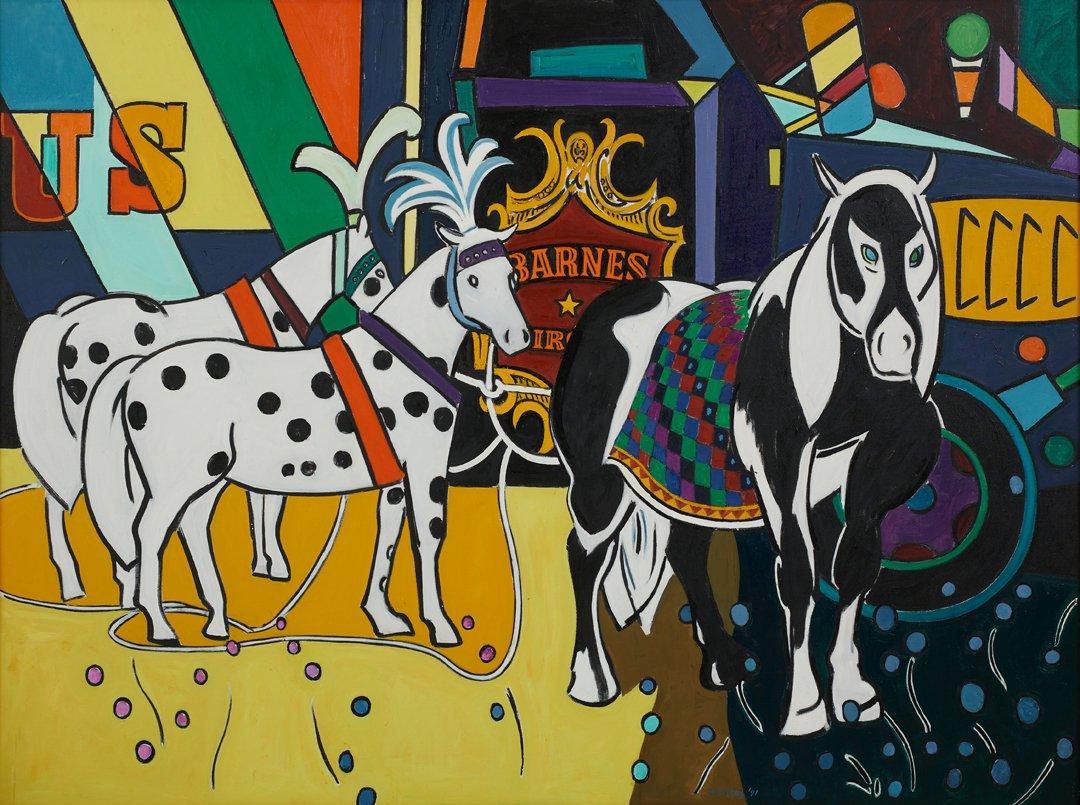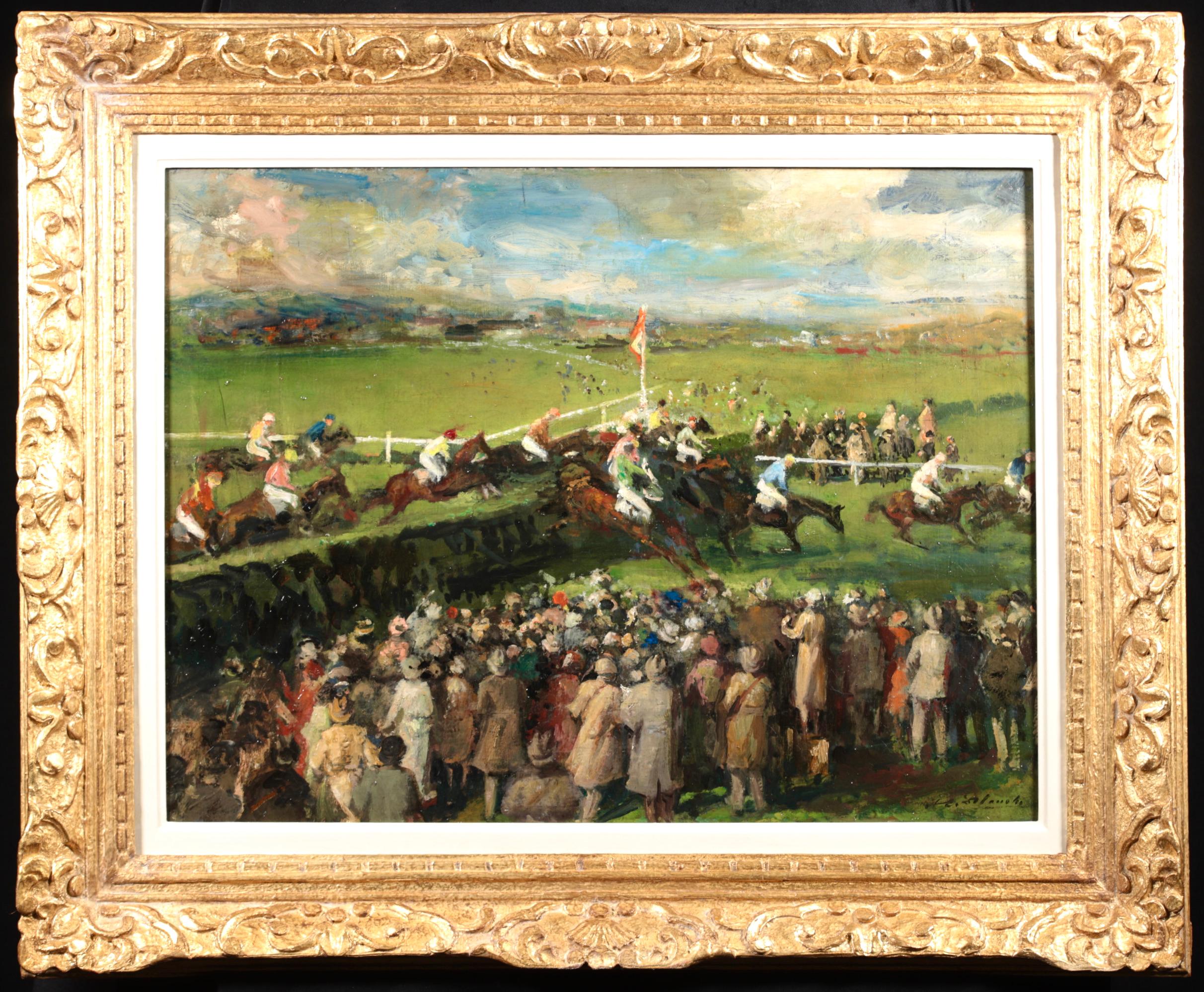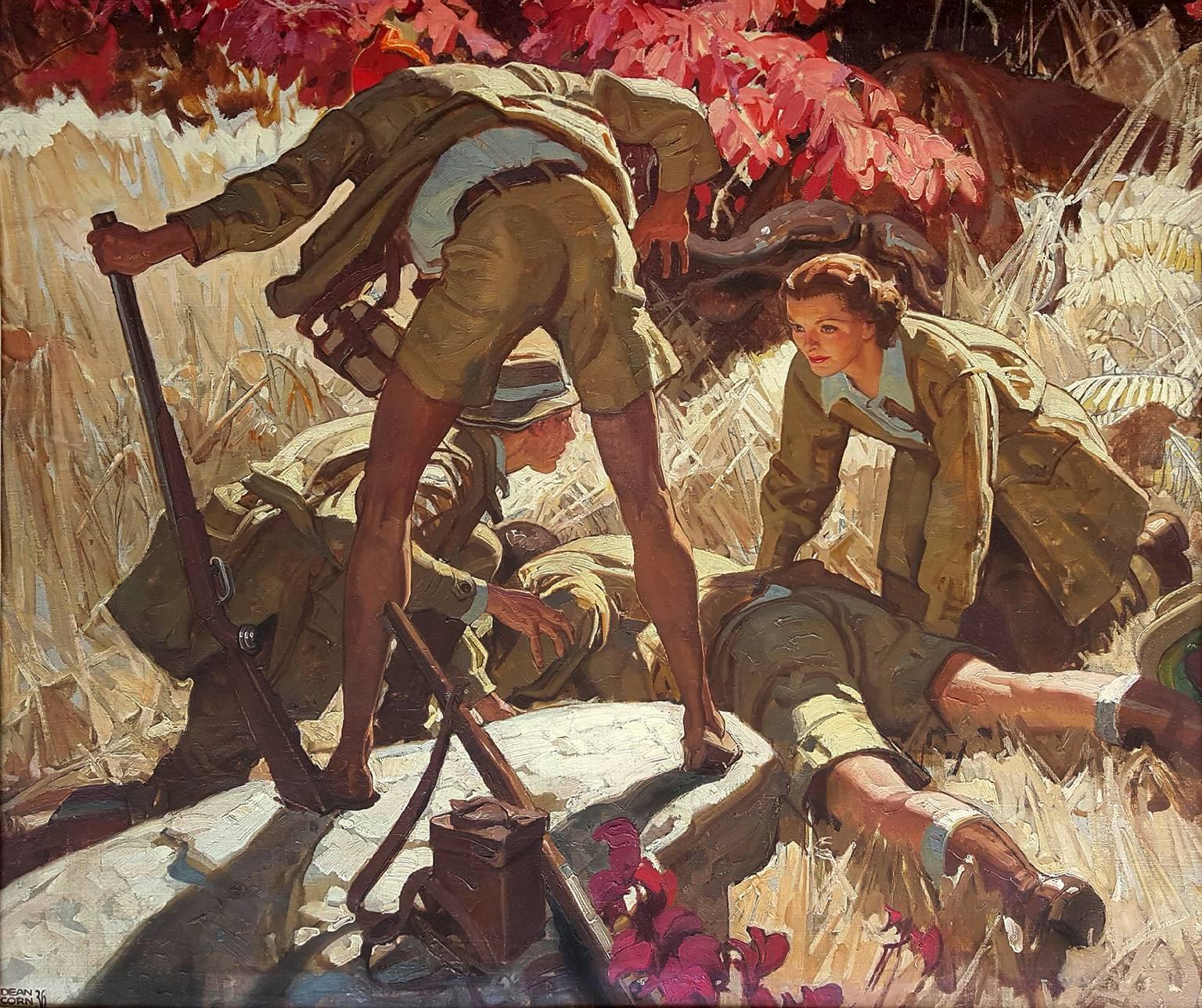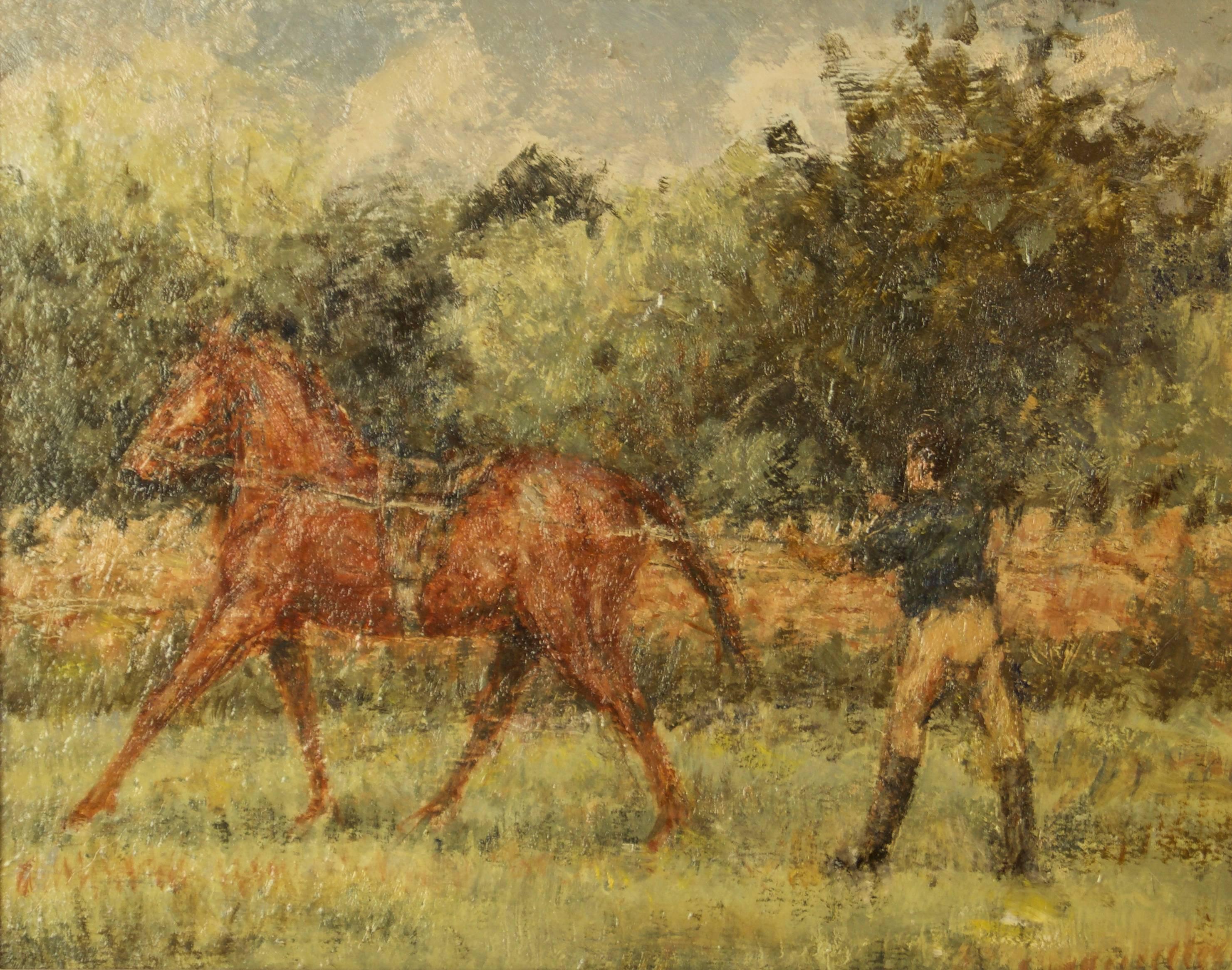Items Similar to FERNAND AUDET (1923-2016) FRENCH IMPRESSIONIST OIL - THE MATADOR & BULL FIGHT
Want more images or videos?
Request additional images or videos from the seller
1 of 11
Fernand AudetFERNAND AUDET (1923-2016) FRENCH IMPRESSIONIST OIL - THE MATADOR & BULL FIGHTMid 20th Century
Mid 20th Century
About the Item
"The Matador"
by Fernand Audet (French, Tarascon 1923- Mulhouse 2016)
signed bottom left
oil painting on board, unframed
painting: 28.75 x 19.5 inches
A fine 20th century oil painting by the listed French Impressionist artist, Fernand Audet (1923-2016). Painted with wonderful thick, impasto oil built up layer upon layer creating a superb textured surface, the artist has captured this beautiful scene. The painting has excellent provenance having come from the artists estate.
Audet exhibited throughout his lifetime, including with the Salon des Independants in France.
Condition report:
The painting is in very good and sound condition. There are minor scuffs from previous storage in the artists studio
- Creator:Fernand Audet (1923 - 2016, French)
- Creation Year:Mid 20th Century
- Dimensions:Height: 28.75 in (73.03 cm)Width: 19.5 in (49.53 cm)
- Medium:
- Movement & Style:
- Period:
- Condition:
- Gallery Location:Cirencester, GB
- Reference Number:1stDibs: LU50939475982

About the Seller
5.0
Platinum Seller
These expertly vetted sellers are 1stDibs' most experienced sellers and are rated highest by our customers.
Established in 1989
1stDibs seller since 2016
3,459 sales on 1stDibs
Typical response time: 2 hours
- ShippingRetrieving quote...Ships From: Cirencester, United Kingdom
- Return PolicyA return for this item may be initiated within 3 days of delivery.
More From This SellerView All
- Herding The Fleet Of Animals French Impressionist Thick Oil ImpastoLocated in Cirencester, GloucestershireHerding Animals by Josine Vignon (French 1922-2022) stamped verso oil painting on canvas, unframed canvas: 22 x 18 inches Colors: Yellow colors, brown, ...Category
Mid-20th Century Post-Impressionist Figurative Paintings
MaterialsOil
- Superb French Post-Impressionist Signed Oil Caravan Scene with Traveling FiguresLocated in Cirencester, GloucestershireArtist/ School: E. DE GRANDIDIER 19-20th Century French Title: Caravan Scene With Figures Medium: signed oil on canvas, framed Size: 19.75 x 24 inches plus the original Montparnas...Category
Mid-20th Century Post-Impressionist Figurative Paintings
MaterialsOil
- The Circus Horses Large French Post Impressionist Oil Circus Ring Interior SceneLocated in Cirencester, GloucestershireThe Circus by Josine Vignon (French 1922-2022) signed oil painting on canvas, unframed canvas: 32 x 24 inches Very good condition Provenance: from th...Category
Mid-20th Century Post-Impressionist Animal Paintings
MaterialsOil, Canvas
- Huge British Modern Oil Young Rider on Horseback Fine Equestrian PortraitLocated in Cirencester, GloucestershireThe English Countryside by Anthony Woodward, British contemporary oil painting on canvas: 40 x 50 inches framed: 47 x 57 inches condition: very good provenance: private collection, UKCategory
21st Century and Contemporary Modern Animal Paintings
MaterialsOil, Canvas
- Enormous French Oil Painting King Louis XIV of France on HorsebackBy Pierre MignardLocated in Cirencester, GloucestershireFrench School, after Pierre Mignard Louis XIV on Horseback oil on canvas, unframed painting: 60 x 41 inches provenance: private collection, UK The paint...Category
20th Century Old Masters Figurative Paintings
MaterialsCanvas, Oil
- Contemporary French Impressionist Oil Still Life Dead Game PheasantLocated in Cirencester, GloucestershireStill Life of Dead Game by Georges Bordonave (French contemporary) dated 1974 signed oil painting on canvas, unframed canvas: 18 x 22 inches condition: very good provenance: from a ...Category
Late 20th Century Impressionist Animal Paintings
MaterialsOil
You May Also Like
- “Paddock, 1961”, 20th Century Oil on Canvas by Spanish Artist Emilio Grau SalaBy Emilio Grau SalaLocated in Madrid, ESEMILIO GRAU SALA Spanish, 1911 - 1975 PADDOCK, 1961 signed "Grau Sala" (lower right) signed again, titled & dated "GRAU SALA / PADDOK / 1961" (on the reverse) oil on canvas 21-3/8 x ...Category
1960s Post-Impressionist Figurative Paintings
MaterialsCanvas, Oil
- Horses Prepared to Perform and Circus Truck, Contemporary American ModernBy Joseph O'SickeyLocated in Beachwood, OHWork sold to benefit the CLEVELAND INSTITUTE OF ART Joseph B. O’Sickey (American, 1918–2013) Horses Prepared to Perform and Circus Truck, Circus Series, 1991 Oil on canvas Signed an...Category
1990s Post-Impressionist Animal Paintings
MaterialsOil
- At the Races - Post Impressionist Horses & Figures Oil by Jacques-Emile BlancheBy Jacques Emile BlancheLocated in Marlow, BuckinghamshireSigned post impressionist horses and figures in landscape oil on canvas by French painter Jacques-Emile Blanche. The work depicts crowds of people enjoying a day at the races and watching a steeplechase horse race as the horses and their jockey's jump a fence. Signature: Signed lower right Dimensions: Framed: 28"x36" Unframed: 21"x29" Provenance: Private French collection. This work has been authenticated by Dr Jane Roberts and a certificate of authenticity will accompany the painting. Blanche received training from Gervex and Fernand Humbert. His grandfather was Émile Antoine Blanche, the psychiatrist who treated the poet Gérard de Nerval on several occasions. He was awarded a gold medal at the Exposition Universelle in Paris in 1900, and was a Commander of the Légion d'Honneur. He was well known in French and British artistic circles, and married the daughter of John Lemoine, the leader of the Diary of the Proceedings ( Journal des Débats), and author of the Life of Brummel. He exhibited his works in London and Paris. Blanche had a wide circle of acquaintances, and the list of portraits which he executed is indicative of the diversity of those who used to meet at his home: Henri Bergson; Stéphane Mallarmé; Henry Bernstein (1902); André Gide (1912); Anna de Noailles (1912); Jean Cocteau (1912); Igor Stravinsky (1915); Francis Jammes (1917); Paul Claudel (1919); Jean Giraudoux; Paul Valéry; Marcel Proust; Max Jacob (1921); Maeterlinck (1931); Debussy; Antoine Bourdelle; George Moore; André Maurois; François Mauriac; Maréchal Foch and the Princess de Broglie. He also wrote novels, which were more or less autobiographical, and essays, such as From David to Degas; Dates; From Gauguin to the Negro Review; Journals of an Artist ( De David à Degas; Dates; De Gauguin à la Revue nègre; Cahiers d'un artiste) in six volumes, and Manet. During meetings at his studio, he used to collect any snippets that would flesh out the essays he wrote, which alternated between being sharp and emotive. He gave them in series to the magazine Comoedia, under the title of Studio Talk. It was said that he aroused tremendous debate, notably with André Lhote, a painter younger than himself, who also doubled as a critic. The latter initially attempted to define the main characteristics of the art of the 'rebellious and charming Jacques Émile Blanche,' but subsequently treated him less generously, referring to a painter 'attached to the notion of 'high-and-mighty' genre painting.' He added that this sort of painting was marvellously illustrated by Manet. The quality of his flat surfaces, the precious greys and silvery light effects cause Jacques Émile Blanche to be compared more with Manet, whom he admired, than with the Impressionists, with whom he was compared in terms of his early works. Nevertheless, his outdoor backgrounds with traces of sometimes vivid colours have something in common with them. In the aftermath of World War I, he spent a long time on an enormous composition entitled Tribute to those who Died in the War. It was executed in a style which was totally different to his work as a whole. He offered this work to the church in Offranville near Dieppe. He also donated around 100 of his works to the Musée des Beaux-Arts in Rouen. He regularly exhibited in Paris, at the Salon of the Société Nationale des Beaux-Arts (also known as the Salon de Mars) from the time it was founded in 1890. At the time of the initial exhibitions held by the Société Nationale des Beaux-Arts, he rapidly gained fame by exhibiting such portraits as Paul Adam and Charles Cottet. He sometimes grouped together several members of the same family in one painting: The Painter Thaulow and His Family in 1895, The Vielé-Griffin Family, and numerous refined portraits of key figures in France and England. Apart from this Salon, for which he was one of the first driving forces and founder members, he was later to put in a great deal of effort on the occasion of the Salon des Tuileries between 1933 and 1939, even though he was by then in his seventies and already famous. He exhibited genre scenes, scenes of fashionable places - like Brighton or Dieppe - and racecourse scenes at the Salon des Tuileries in 1933. These included Family of Pedlars in London; Portrait of the Female Novelist Sylvia Thompson; Racecourses in Ireland; Arrival of the Herring in Dieppe; White Masts; Brighton; in 1934: Portrait of James Joyce; Grand National Steeplechase; Spring Races in England (sketch); Dieppe Beach; Outer Harbour of Dieppe in Autumn; in 1935: Rugby; Walter Richard Sickert; Dieppe; Tea Party at the Madeleine; in 1939: Love Thy Neighbour. Many exhibitions have been dedicated to him since his death, including one at the Musée des Beaux-Arts in Rouen in 1997, and one at the Galerie Philippe Heim in Paris in 1999. Museum and Gallery Holdings: Brussels: Portrait of the French Painter Charles Cottet Dieppe: Sleeping Child; Fish Week Dijon: General Mangin; The Sailing Ship London (Tate Collection): Francis Poictevin (1887, oil on canvas, portrait); Charles Conder (1904, oil on canvas, portrait); Ludgate Circus: Entrance to the City (November, Midday) (c. 1910, oil/panel); August Morning, Dieppe Beach (c. 1934, oil on canvas); other paintings Lyons: Portrait of Debussy Mulhouse: Begonias Paris (Louvre): The Painter Thaulow and his Family (1895) Paris (MAM): The Pink Room; The Port at Le Havre; Flowers in a Vase; Still-life; Portrait of the Artist's Mother (June 1895); Portrait of Igor Stravinsky Paris (Mus. Carnavalet): Portrait of Jean Cocteau...Category
Mid-20th Century Post-Impressionist Animal Paintings
MaterialsOil, Canvas
- Ernest Hemingway. The Short Happy Life of Francis Macomber He Lay Face DownBy Dean CornwellLocated in Miami, FLA complex composition of interlocking pyramids defines Cornwell not only as a great storyteller but a master of painting fundamentals and design. There exists no living artist today who can paint and draw on a level as Dean Cornwell. Published in Cosmopolitan magazine: "The Short Happy Life of Francis Macomber" by Ernest Hemingway Reproduced in Dean Cornwell, Dean of Illustrators (Broder) The work is rendered in the painterly style of a school of impressionism. Dean Cornwell was Normam Rockwell's favorite Illustrator. He was a student of Harvey Dunn, he in turn taught artists and developed talents for a generation. Oils for Cosmopolitan, Redbook, True, American Weekly, Life, Good Housekeeping. Book art for Man from Galilee and others. Ad contracts for GM, Eastern, Pennsylvania Railroad, Paul Jones Whiskey, Aunt...Category
1930s Post-Impressionist Figurative Paintings
MaterialsOil
- Training Day - Mid 20th Century Impressionist Oil Horse & Jockey by Kay HinwoodBy Kay HinwoodLocated in Watford, HertfordshireKay Hinwood (1920 - 2006) This piece titled Training Day was created using oil on board and is in a handmade swept composite frame. It features: Horse, horses, training, people, ho...Category
1940s Post-Impressionist Animal Paintings
MaterialsOil, Board
- Sheep Shearers, Tangiers - British 1920's Orientalist figurative oil paintingBy Gerald Spencer PryseLocated in London, GBThis superb vibrant Orientalist Post Impressionist oil painting is by noted British artist Gerald Spencer Pryse. It was painted about 1925 when Pryse was visiting Morocco and Norther...Category
1920s Post-Impressionist Animal Paintings
MaterialsOil
Recently Viewed
View AllMore Ways To Browse
The Vintage List
French Bull
Mid Century Bull
Bull Art Mid Century
Matador Vintage
Fight Scene Oil
Bull Fighting Paintings
Paintings Bull Fight
Matador Oil
Matador Paintings
Fernand Audet
Vintage Bull Matador
Retro Matador Painting
Midcentury Matador Paintings
Green Fairy
Oil Drum
Oil Paintings Arab
Hawaiian Vintage Art




